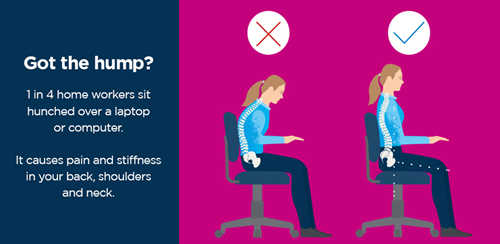Working from home amid the COVID-19 pandemic has had an additional health impact with 11 million Brits in pain as a result of their home working environment. We tap into UK experts who advise on how to prevent further ‘hurting from home’.
Millions of Brits are in pain as a result of their makeshift home offices as the UK enters its eighth week of social distancing.1
People have been urged to work from home to help contain the COVID-19 pandemic – something that is likely to continue even as lockdown measures are relaxed – but according to new research from Bupa UK nearly two thirds (63%), equating to 11 million Brits, have injured their back, neck, hips, knees or wrists, amongst other injuries as a result.2
Only one in three (32%) has a dedicated workspace in their home, and as a result, home workers are using their sofas, kitchen chairs, beds or even beanbags as makeshift workstations.3
And it means that a quarter of home workers are hunched over their computers for eight hours a day while others admit to slouching or slumping in their seats, balancing their computer on laps or the arm of a chair, or sitting with their back or legs twisted to try to get comfortable.4
Younger people are disproportionately affected – workers aged 18-34 are least likely to have a simple desk and a chair with a backrest, and are twice as likely to work from their bed as their older counterparts.5 But as a result this age group reports the highest levels of neck, hip, knee and wrist pain.6
But just one in ten (11%) has sought medical help, with the majority using over-the-counter painkillers, massages or ice baths.7 Worryingly, 28 per cent have done nothing to relieve their symptoms – but without proper treatment they risk longer term damage.

Damian McClelland, Clinical Director for Musculoskeletal Services at Bupa UK Insurance commented: “When social distancing measures were introduced many workers were thrust into working from home to keep them safe, with little time to prepare their workspaces. So it’s concerning, but perhaps not surprising, to see that so many are now struggling with their muskuloskeltal health.”
And with two in five (42%) home workers intending to continue working from home when social distancing measures are lifted, musculoskeletal experts at Bupa UK have developed a guide identifying the most common home working archetypes, and detailing simple changes to make life more comfortable and avoid long term damage.
Top Tips for MSK health
Damian McClelland has shared his top tips for protecting your MSK health while working from home: ““As we move towards the ‘new normal’ where higher levels of working from home are likely to feature, it’s really important to address any pain or discomfort now, to make this sustainable in the long term.
“Simple changes such as ditching the beds and beanbags and sitting up with your feet planted on the floor, adopting handsfree sets for long phonecalls, and making time to stretch (even if that’s doing yoga at your desk) can go a long way to preventing strain. And seeking help for long term and persistent pain remains essential. Early diagnosis and access to treatment can have a positive effect on the long-term prognosis of musculoskeletal conditions.”
Notes
Research conducted among 2,003 UK adults by Opinium Research between 24-27 April 2020.
- Opinium estimates the UK adult population is 52,079,000. According to research undertaken by Opinium 34% of adults are currently working or home schooling from home (or 17,706,860 individuals). Of home workers 63% reported aches, pains or injury, equating to 11,155,322.
- Of those home working / home schooling, 30% have experienced back pain, 22% neck pain, 16% wrist, hand, arm pain, 15% hip pain, 12% knee pain
- 18% work from sofa or armchair, 17% work from dining or kitchen chair, 12% work in bed, 5% work on a beanbag
- 24% are often hunched. 18% slouch or slump, 12% balance a computer on legs, 11% on the arm of a chair, 10% sit with their back or legs (11%) twisted
- Only 26% of 18-34 year olds have a desk and chair with backrest compared to 30% of 35-54 and 33% of 55+ while 18% of 18-34 year olds work from bed (compared to 9% of 35-54 year olds)
- 24% of 18-34s have neck pain (v.22% in 35- 54 year olds and 16% of those aged 55+), hip pain = 20% v. 11%, knee pain = 13% v. 12, wrist pain = 20% v. 13%
- 30% have tried to manage the injury themselves with medication e.g. painkillers, and 29% Tried to treat the injury with non-medical treatments (e.g. ice baths/ a massage from someone I live with)
You can read the Bupa press release in full here.



